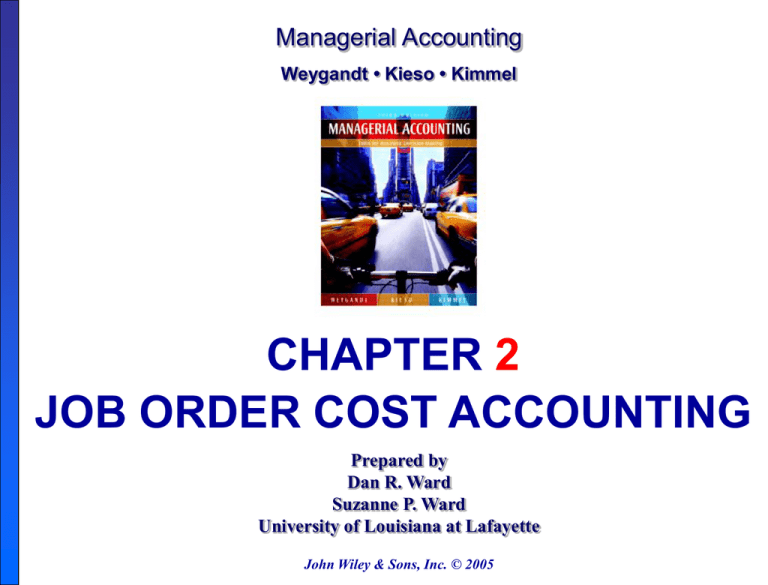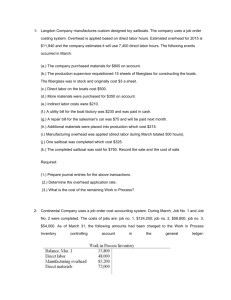
Managerial Accounting
Weygandt • Kieso • Kimmel
CHAPTER 2
JOB ORDER COST ACCOUNTING
Prepared by
Dan R. Ward
Suzanne P. Ward
University of Louisiana at Lafayette
John Wiley & Sons, Inc. © 2005
CHAPTER 2
JOB ORDER COST ACCOUNTING
Study Objectives
Explain the characteristics and purposes of
cost accounting.
Describe the flow of costs in a job order cost
accounting system.
Explain the nature and importance of a job
cost sheet.
Study Objectives: Continued
Indicate how the predetermined overhead
rate is determined and used.
Prepare entries for jobs completed and sold.
Distinguish between under- and over-applied
manufacturing overhead.
COST ACCOUNTING SYSTEMS
Study Objective 1
Cost accounting involves
The measuring
The recording, and
The reporting of product costs
Consists of the various manufacturing costs that are
fully integrated into the general ledger system.
An important feature is the use of a
perpetual inventory system to provide
immediate, up-to-date information on the
cost of a product.
COST ACCOUNTING SYSTEMS
There are two basic types of
cost accounting systems:
and
COST ACCOUNTING SYSTEMS
Job Order Cost System
Costs are assigned to each job or batch
A job may be for a specific order or inventory
A key feature:
Each job or batch has its own distinguishing
characteristics
The objective: to compute the cost per job
Measures costs for each job completed - not for
set time periods
COST ACCOUNTING SYSTEMS
Job Order Cost System
COST ACCOUNTING SYSTEMS
Process Cost System
Used when a large volume of similar products are
manufactured.
Cereal
Automobiles
Compact Discs
Paint
Cost are accumulated for a specific time period
(a week or a month)
Costs are assigned to departments or processes for a
set period of time.
COST ACCOUNTING SYSTEMS
Process Cost System
JOB ORDER COST FLOWS
Study Objective 2
The cost flow parallels the physical flow of the
materials as they are converted into finished
goods.
Manufacturing costs are assigned to Work in
Process.
Cost of completed jobs is transferred to Finished
Goods Inventory.
When units are sold, the cost is transferred to Cost of
Goods Sold.
JOB ORDER COST FLOWS
Overview
JOB ORDER COST FLOWS
System
Two Major Steps in Flows of Costs
Accumulate the manufacturing costs
incurred
Raw materials
Factory Labor
Manufacturing Overhead
Assign the accumulated costs to the
work done
ACCUMULATING MANUFACTURING COSTS
Raw Materials Costs
Raw materials are debited to Raw Materials
Inventory when purchased.
At this point, the cost of materials is not assigned to
specific jobs or orders.
Example:
On January 4, Wallace Manufacturing purchases 2,000 handles at $5 per
unit ($10,000) and 800 modules at $40 per unit ($32,000) for a total cost of
$42,000.
ACCUMULATING MANUFACTURING COSTS
Raw Materials Costs - Continued
Raw Materials Inventory –
a general ledger account
a control account that summarizes the
detailed data regarding specific inventory
accounts in the subsidiary ledger.
ACCUMULATING MANUFACTURING COSTS
Raw Materials Costs - Continued
The subsidiary ledger consist of individual records for
each item of raw materials.
May be accounts or manually/mechanically prepared cards
May be kept as computer data files
The records are referred to as materials inventory
records or stores ledger cards.
ACCUMULATING MANUFACTURING COSTS
Factory Labor Costs
Consists of
gross earnings of factory workers,
employer payroll taxes on such earnings, and
fringe benefits incurred by the employer.
Debited to Factory Labor when incurred.
Example:
Wallace Manufacturing incurs $32,000 of factory labor costs, of which
$27,000 relates to wages payable and $5,000 relates to payroll taxes payable
in January.
ACCUMULATING MANUFACTURING COSTS
Manufacturing Overhead Costs
May be recognized daily
For example, machinery repairs , indirect materials, and indirect labor.
May also be recorded periodically through adjusting
entries
For example, property taxes, depreciation, and insurance.
The summary entry for Wallace Manufacturing Company is:
Manufacturing overhead is a Control Account.
ASSIGNING MANUFACTURING COSTS TO
WORK IN PROCESS
Study Objective 3
Manufacturing costs are assigned to work in
process with
Debits to Work in Process Inventory
Credits to
• Raw Materials Inventory
• Factory Labor
• Manufacturing Overhead
Entries assigning costs to work in process are
usually made monthly
ASSIGNING MANUFACTURING COSTS TO
WORK IN PROCESS
Job cost sheet
Used to record the costs of a specific job.
Used to determine the total and unit costs of a
completed job.
Postings to job cost sheets are made daily.
ASSIGNING MANUFACTURING COSTS TO
WORK IN PROCESS – Raw Materials Cost
Assigned to a job when materials are issued.
A materials requisition slip - the written authorization
for issuing raw materials.
May be either directly used on a job or may be
considered indirect materials.
ASSIGNING MANUFACTURING COSTS TO
WORK IN PROCESS – Raw Materials Cost
Requisition is prepared in duplicate.
One copy stays in the storeroom as evidence of materials
released.
The original goes to accounting to determine the cost per
unit and total cost of materials used.
Posted daily to individual job cost sheets and periodically
journalized.
Example:
If $24,000 of direct materials and $6,000 of indirect materials are used in
January, the entry is
ASSIGNING MANUFACTURING COSTS TO
WORK IN PROCESS – Raw Materials Cost
The sum of the direct materials columns of the job cost sheets should
equal the direct materials debited to Work in Process Inventory.
ASSIGNING MANUFACTURING COSTS TO
WORK IN PROCESS – Factory Labor Cost
Assigned to jobs on the basis of time tickets.
Time tickets indicate
Employee
Hours worked
Account and job charged
Total labor cost
ASSIGNING MANUFACTURING COSTS TO
WORK IN PROCESS – Factory Labor Cost
Time tickets are sent to payroll to be sorted, totaled,
and journalized.
Work in Process is debited for direct labor costs.
Manufacturing overhead is debited for indirect labor
costs.
Factory Labor is left with a zero balance.
Example:
If the $32,000 total factory labor cost incurred consists of $28,000 of direct
labor and $4,000 of indirect labor, the entry is
ASSIGNING MANUFACTURING COSTS TO
WORK IN PROCESS – Factory Labor Cost
The sum of the direct labor columns of the job cost sheets should
equal the direct labor debited to Work in Process Inventory.
ASSIGNING MANUFACTURING COSTS TO
WORK IN PROCESS – Manufacturing Overhead
Study Objective 4
Relates to production operations as a whole
Cannot be assigned to specific jobs based on actual
costs incurred
Must be assigned to work in process and to specific
jobs on an estimated basis through the use of a
ASSIGNING MANUFACTURING COSTS TO
WORK IN PROCESS – Manufacturing Overhead
Predetermined Overhead Rate
Based on the relationship between estimated
annual overhead costs and expected annual
operating activity.
Expressed in terms of an activity base such as
Direct labor costs
Direct labor hours
Machine hours, or
Any other activity that is an equitable base for
applying overhead costs to jobs
ASSIGNING MANUFACTURING COSTS TO
WORK IN PROCESS – Manufacturing Overhead
Predetermined Overhead Rate
Established at the beginning of the year.
May use a single, company-wide predetermined rate.
May use a different rate for each department and each
department may have a different activity base.
The formula for a predetermined overhead rate is
ASSIGNING MANUFACTURING COSTS TO
WORK IN PROCESS – Manufacturing Overhead
Assigned to work in process during the period to get timely
information about the cost of a completed job.
Current trend is to use machine hours as the activity base due to
increased automation in manufacturing operations.
ASSIGNING MANUFACTURING COSTS TO
WORK IN PROCESS – Manufacturing Overhead
Example:
At Wallace Manufacturing, direct labor cost is the activity base.
Estimated annual costs:
Overhead costs
$280,000
Direct labor costs
$350,000
The overhead rate is
$280,000 ÷ $350,000 = 80% of direct labor cost
Overhead applied for January is $22,400 ($28,000 X 80%) and
is recorded through the following entry.
ASSIGNING MANUFACTURING COSTS TO
WORK IN PROCESS – Manufacturing Overhead
The sum of the manufacturing overhead columns of the job cost sheets
should equal the manufacturing overhead debited (i.e., applied) to
Work in Process Inventory.
ASSIGNING MANUFACTURING COSTS TO
WORK IN PROCESS - At the End of Each Month
The balance in Work in Process Inventory
should equal the sum of the costs shown on
the job cost sheets of unfinished jobs.
ASSIGNING COSTS TO FINISHED GOODS
Study Objective 5
When a job is
completed, the
costs are
summarized and
the job cost
sheet is
completed.
The entry for
Wallace
Manufacturing
to transfer its
total cost to
finished goods:
ASSIGNING COSTS TO FINISHED GOODS
Inventory remains in Finished Goods Inventory
until it is sold.
Cost of goods sold is recognized when a sale occurs.
Example:
On January 31 Wallace Manufacturing sells Job No. 101, costing
$39,000, for $50,000. The entries are:
SUMMARY OF JOB ORDER COST FLOWS
SUMMARY OF JOB ORDER COST FLOWS
REPORTING JOB COST DATA
The cost of goods manufactured schedule now shows
manufacturing overhead applied rather than actual overhead
costs.
Applied overhead is added to direct materials and direct labor
to determine total manufacturing costs
Let’s Review
In recording the issuance of raw
materials in a job order cost system, it
would be incorrect to:
a. Debit Work in Process Inventory
b. Debit Finished Goods Inventory
c. Debit Manufacturing Overhead
d. Credit Raw Materials Inventory
Let’s Review
In recording the issuance of raw
materials in a job order cost system, it
would be incorrect to:
a. Debit Work in Process Inventory
b. Debit Finished Goods Inventory
c. Debit Manufacturing Overhead
d. Credit Raw Materials Inventory
UNDER- OR OVERAPPLIED
MANUFACTURING OVERHEAD
Study Objective 6
A debit balance in manufacturing overhead means
that overhead is underapplied.
Overhead assigned to work in process is less than
overhead incurred.
A credit balance in manufacturing overhead means
that overhead is overapplied.
Overhead assigned to work in process is greater than
overhead incurred.
UNDER- OR OVERAPPLIED
MANUFACTURING OVERHEAD
Any year-end balance in Manufacturing Overhead
is eliminated by adjusting cost of goods sold.
Underapplied overhead is debited to CGS
Overapplied overhead is credited to CGS
Example:
Wallace Mfg. has a $2,500 credit balance in Manufacturing Overhead
at December 31. The adjusting entry for the overapplied overhead is
Summary of Study Objectives
Explain the characteristics and purposes of cost
accounting.
Involves measuring, recording, and reporting product costs.
The two basic types of cost accounting systems:
Job Order Costing and Process Costing
Describe the flow of costs in a job order cost accounting
system.
Manufacturing costs are first accumulated in three accounts:
Raw Materials Inventory
Factory Labor
Manufacturing Overhead
The accumulated costs are then assigned to Work in Process.
As jobs are completed, the Work in Process costs are then
assigned to Finished Goods.
Once goods are sold, the Finished Goods costs are then assigned
to Cost of Goods Sold.
Summary of Study Objectives
Explain the nature and importance of
a job cost sheet.
A form used to record costs charged to a
specific job and to determine the total
and unit costs of the completed job.
A subsidiary ledger for Work in Process
Inventory.
Indicate how the predetermined
overhead rate is determined and used.
Based on the relationship between
estimated annual overhead costs and
expected annual operating activity.
Used to assign overhead costs to both
work in process and to specific jobs.
Summary of Study Objectives
Prepare entries for jobs completed and sold
Completed jobs:
Debit Finished Goods Inventory and credit Work in Process
Inventory
When a job is sold:
Debit Cash or Accounts Receivable and credit Sales
Debit Cost of Goods Sold and credit Finished Good Inventory
Distinguish between under- and overapplied manufacturing
overhead.
Underapplied manufacturing overhead
Overhead assigned to work in process is less than the overhead
incurred
Overapplied manufacturing overhead
Overhead assigned to work in process is greater than the
overhead incurred
Let’s Review
Manufacturing overhead is underapplied if:
a. Actual overhead is less than applied
b. Actual overhead is greater than applied
c. The predetermined rate equals the actual
rate
d. Actual overhead equals applied overhead
Let’s Review
Manufacturing overhead is underapplied if:
a. Actual overhead is less than applied
b. Actual overhead is greater than applied
c. The predetermined rate equals the actual
rate
d. Actual overhead equals applied overhead
COPYRIGHT
Copyright © 2005 John Wiley & Sons, Inc. All rights reserved. Reproduction or
translation of this work beyond that permitted in Section 117 of the 1976 United
States Copyright Act without the express written consent of the copyright owner is
unlawful. Request for further information should be addressed to the Permissions
Department, John Wiley & Sons, Inc. The purchaser may make back-up copies for
his/her own use only and not for distribution or resale. The Publisher assumes no
responsibility for errors, omissions, or damages, caused by the use of these
programs or from the use of the information contained herein.








